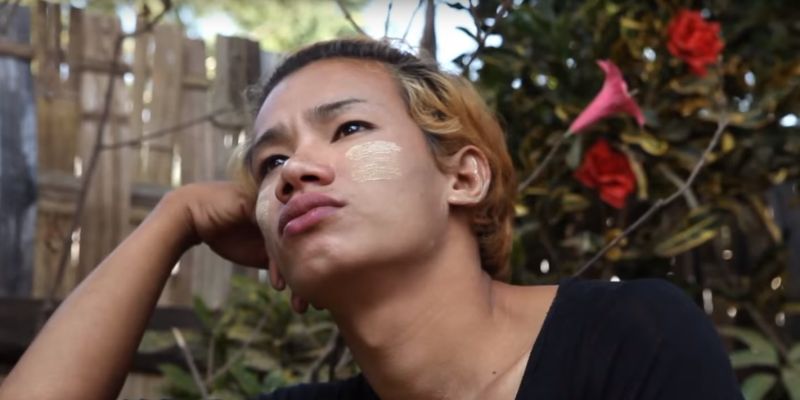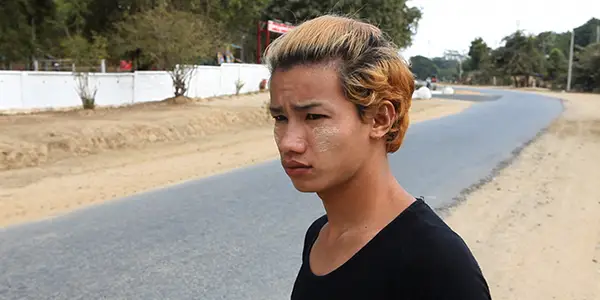IRRAWADDY MON AMOUR: Love Refuses to Wait For Acceptance

Arlin is an all-around film person in Oakland, CA. He…
As the Western world is finally starting to make significant strides towards sexual orientation equality, it is easy to forget that in most of the rest of the world homosexuals are less than accepted in their respective societies. LGBT people in such countries face discrimination, social exile and physical beatings as punishment for their existence, and as such have largely been forced to stay closeted. But Love is one of those things that is hard to keep hidden, and as one wise man once said about Life, Love too often “finds a way”. For some gay men in Myanmar, a country redefining itself in the wake of a brutal totalitarian regime, that way is Myo Nyunt, the focus of Irrawaddy Mon Amour.
Nyunt leads a group of homosexuals based along the Irrawaddy river in central Myanmar. Shunned from their homes and communities, the group acts as a makeshift family for gay men with no where else to turn. But his main role is even more subversive than that: in a nation where gay sex is still forbidden by law, Nyunt covertly organizes gay marriages, presided over by Buddhist monks in alliance with his cause.
Irrawaddy concerns itself with one particular couple set to be married: Soe Ko, a watermelon salesman and master of cephalic balance, and his tuck-pointing, gambling, city-dwelling fiancé Saing Ko. Through Nyunt’s expert wedding planning the Ko’s hope to become a family like any other in Myanmar.
Framing Normalcy
Directors Nicola Grignani, Valeria Testagrossa and Andrea Zambelli employ a Direct Cinema approach to great effect, presenting all the players as they are, without any commentary and minimal artifice. The cinematography by Testagrossa and Zambelli is stunning, as they often utilize beautifully composed static shots that would not seem out of place in a scripted drama, such as one brief scene where Nyunt relaxes at a shrine of bananas.

The film opens with a powerful shot of Nyunt, as of yet unidentified, riding in a boat down the Irrawaddy. He appears both strong, confident, but also feminine, as he proudly sports a shining earring angled directly at the camera. This is after all a very young nation with a founding mother figure, Aung San Suu Kyi, invoked in a political speech by Nyunt, so it is thus also a nation accepting of femininity in their leaders, and as such those loyal to him refer to Nyunt as “mother”. He takes care of them as a mother would, sheltering them from harm (literally in the case of Saing Ko) and guiding them through life as a gay man in Myanmar.
The subjects of the film are simultaneously othered and assimilated, as we are shown their daily activities and rituals that we can only assume are outside the norm of Myanmarese society, as they likely would be for men in our own, acts such as dressing in drag, doing women’s dances and working in hair and make-up. But within the context of the film, and by extension the context of the Irrawaddy homosexual community, they are completely commonplace and accepted, illustrating how inclusion is entirely subjective and tied to particular situations. Aside from the fact that the ceremony is to be held between two men, all the proceedings, from an astrology consultation, to karaoke, are fantastically commonplace, and further demonstrate the contextual basis for the formation of societal norms.

I am reminded at times of the seminal documentary Paris Is Burning, as the men of the Irrawaddy are actively participating in the performance of “realness”, that is, in “becoming” the Myanmarese pop-star on tv with the pierced ears or the priestess, with three cigarettes in their nose to go with the two in their mouth. The comparison is especially pronounced in one scene, that is basically the Myanmarese version of a “ball” where gay men gather to perform as women, all to a phenomenal soundtrack (the percussionist in this scene kills it).
But the most significant point of overlap is with regards to what is called in Paris a “house”, that is a group of gay and trans men that have come together under one “mother” (the term is the same here) to replace the family that cast them aside. It seems then that unity spun from ostracism is something common to gay men across cultures and borders, and is a necessary step in political advancement.
Conclusion
It is incalculably frustrating that for all the globalization and modern imperialism that has become the planetary norm that only the most benign cultural aspects of the West are assimilated by developing nations. One of the subjects of the film, Htet Htet, has a Britney Spears poster on his wall, for another it’s Minnie Mouse, and at the wedding itself some little boys (adorably) perform “Gagnam Style”.

Yet little of the progressive political ideas about sexuality and gender seems to have permeated Myanmarese culture, at least outside of those directly affected. Perhaps Western nations should organize a tour of Queer culture akin to the Jazz tours of Europe in the first half of the twentieth century, in order to better disseminate modern ideas about human rights.
Irrawaddy Mon Amour, in addition to being beautifully photographed, is also brilliantly paced, taking the time to be meditative without ever lingering; when it’s over you feel both as if you wish it was longer but satisfied by what you just watched. In this way the structure of the film is analogue to the Myanmarese homosexual experience itself, as they can’t afford to linger for too long, less they should be noticed and punished by the authorities. As Nyunt exclaims, their love, and that of the film, “flows like the Irrawaddy river”: you have to enjoy it while it’s there, because soon it will have moved on.
What do you think are the best ways to speed up international LGBT human rights?
Irrawaddy Mon Amour just had its World Premiere at IDFA and is currently wrapping up an Indiegogo campaign
Does content like this matter to you?
Become a Member and support film journalism. Unlock access to all of Film Inquiry`s great articles. Join a community of like-minded readers who are passionate about cinema - get access to our private members Network, give back to independent filmmakers, and more.
Arlin is an all-around film person in Oakland, CA. He received his BA in Film Studies in 2010, is a documentary distributor and filmmaker, and runs Drunken Film Fest Oakland. He rarely dreams, but the most frequent ones are the ones where it's finals and he hasn't been to class all semester. He hopes one day that the world recognizes the many values of the siesta system.












